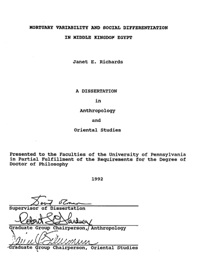| Main » Ad Board » ДРЕВЕН ЕГИПЕТ И АФРИКА » Археология |
| 08.11.2019, 13:41 | |
Дисертацията анализира материала от погребения през Средното царство (некрополите в Северен Абидос, Харага и Рика) като големина на гробниците, богатство на гробния инвентар и здравословно състояние на погребаните там (следи от тежък труд, хранене, болести). Основната цел с помощта на това изследване да се очертае социалната диференциация през онази епоха. Търсят се и отговори на социални въпроси като имало ли е "средна класа", доколко тя е била отворена и дали държавата е упражнявала тотален контрол над индивидите и социалните групи. Janet E. Richards- Mortuary variability and social differentiation in Middle Kingdom Egypt, Philadelphia, University of Pennsylvania, 1992- на английски език, от Google Docs,формат PDF. Сваляне с ляв бутон (downloading by left button) от страницата на предоставящия сървър, после през бутона стрелка надолу/after by down arrow button.
| |
| Views: 989 | Placed till: 08.12.2019 | Rating: 0.0/0 | |

